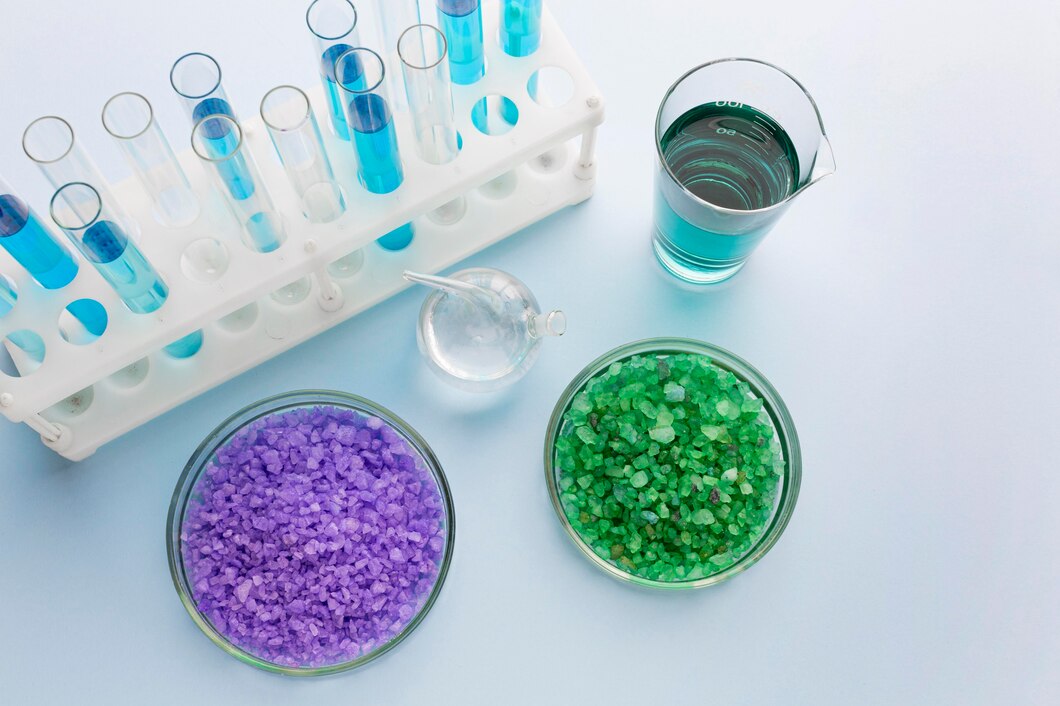المحتويات
مقدمة
علم الكيمياء هو أحد المجالات الرئيسية للعلوم الطبيعية، حيث يهتم في دراسة المادة وخصائصها وتركيبها. علم الكيمياء لا يقتصر فقط على التفاعلات المعقدة في المختبرات بل هو أساس حياتنا، على سبيل المثال: هل فكرت يوماً عن سبب غليان الماء عند درجة حرارة معينة؟ أو كيف يذوب السكر في الماء؟ الكيمياء ليست مجرد معادلات؛ بل هي الفن الذي يجعلنا نفهم الكون من حولنا. في هذا المقال سنتعرف على مفهوم علم المواد الذي هو الأساس لفهم علم الكيمياء.
مفهوم المادة:
المادة هي أي جسم يشغل حيزاً من الفراغ. بمعنى آخر هي أي جسم له كتلة وحجم. تشمل المادة كل الأجسام التي نراها حولنا، حتى تلك التي لا يمكن رؤيتها بالعين المجردة، سواء كان صلباً كالهاتف الذي بين يديك، أو سائلاً كالماء الذي تشربه، أو غازياً كالهواء الذي تتنفسه. إذاً المادة هي الأساس الذي نبني عليه حياتنا من الغذاء إلى التكنولوجيا.
أمثلة على المواد من حولنا:
-
المعادن والصخور الموجودة في الأرض (مواد صلبة)، تستخدم في البناء والصناعة.
-
الماء (مادة سائلة)، يغطي معظم سطح الأرض.
-
الغازات وهي عبارة عن مواد غير مرئية مثل: الأكسجين، النيتروجين، وثاني أكسيد الكربون.
خصائص المواد:
أولاً: الخواص الشمولية (extensive properties):
هي الخواص التي تعتمد على كمية المادة، أي كلما زادت كمية المادة؛ زادت قيمة الخاصية لها. من الأمثلة عليها:
-
الحجم: كمية الحيز الذي تشغله المادة.
-
الكتلة: مقدار المادة الموجودة.
ثانياً: الخواص النوعية (intensive properties):
هي الخواص التي لا تعتمد على كمية المادة، بمعنى آخر هي الخواص التي تبقى ثابتة بغض النظر عن كمية المادة. من الأمثلة عليها:
-
الكثافة: نسبة الكتلة إلى الحجم.
-
درجة الحرارة: نسبة الحرارة في جسم ما.
مثال عملي توضيحي:
إذا كان لديك كوباً من الماء بسعة 100 مل، وأضفت إليه كوباً آخر بسعة 100 مل؛ فستصبح السعة الإجمالية من الماء 200 مل. نستنتج من ذلك أن بزيادة كمية المادة (الماء) يزداد الحجم (الكمية الشمولية).
في المقابل، تبقى الكثافة ودرجة الحرارة ثابتة بغض النظر عن زيادة الكمية لأنها خاصية نوعية (intensive)؛ لا تتأثر بكمية المادة.
الفرق بين التغير الفيزيائي والتغير الكيميائي للمادة
-
التغير الفيزيائي للمادة:
هو التغير في المظهر الفيزيائي للمادة دون التأثير على هويتها أي "تركيبها الكيميائي".
أمثلة:
-
درجة الانصهار: وهي درجة الحرارة التي تتحول عندها المادة من الحالة الصلبة إلى الحالة السائلة مثل: ذوبان الجليد.
-
درجة الغليان: وهي درجة الحرارة التي تتحول عندها المادة من الحالة السائلة إلى الحالة الغازية، مثل: غليان الماء.
-
لون المادة.
-
التغير الكيميائي للمادة:
هو التغير في التركيب الكيميائي للمادة، أي تحول مادة أو أكثر إلى مركب جديد تختلف خصائصه اختلافاً كلياً عن المواد الأصلية.
أمثلة:
-
عملية التأكسد والاختزال: وهي عملية فقدان أو اكتساب الكترونات، مثل: صدأ الحديد الذي ينتج من تفاعل الحديد مع الماء ليعطي أكاسيد الحديد.
-
عملية الاحتراق: مثل احتراق الخشب ليتحول إلى رماد وغازات أخرى وهي مواد جديدة تختلف في تركيبها عن المادة الأصلية "الخشب".
من الجدير بالذكر أن كل تغير كيميائي يتبعه تغير فيزيائي. حيث يؤدي التغير في التركيب الكيميائي إلى اكساب المادة خواص فيزيائية جديدة.
تصنيف المواد:
أولاً، المواد النقية (Pure substances): تصنف إلى عناصر ومركبات:
-
العناصر (Elements):
أحد المواد النقية التي لا يمكن أن يتم تقسيمها إلى مواد أبسط منها، سواء تعرض لتغيير فيزيائي أو كيميائي. يوجد حوالي 118 عنصر في الجدول الدوري، 90 من العناصر يتم استخلاصه من المصادر الطبيعية، أما الباقي يتم تصنيعه صناعياً في المختبرات.
أمثلة: الحديد (Fe)، الذهب (Au)، الأكسجين (O)
-
المركبات (Compounds):
المركب هي المادة التي تتكون من عنصرين أو أكثر بنسب ثابتة. ويمكن تكسير المركب وتحويله إلى مواد أبسط ألا وهي العناصر عن طريق التفاعلات الكيميائية. بكلماتٍ أخرى، عن طريق تطبيق تغيير كيميائي على المركب كما ذكرنا مسبقاً. ولا تؤثر التغيرات الفيزيائية عليه.
أمثلة: الماء (H2O)، ملح الطعام "كلوريد الصوديوم" (NaCl)
ثانياً، المخاليط (mixture): عبارة عن مزيج من مادتين أو أكثر دون حدوث تفاعل كيميائي بينهم؛ بحيث تحتفظ كل مادة بخصائصها الأصلية. وتنقسم إلى قسمين:
-
المخاليط المتجانسة:
تعرف المخاليط المتجانسة باسم المحاليل (solutions). تتوزع مكونات المحلول بشكل منظم؛ بحيث يصعب التمييز بين المواد المخلوطة.
أمثلة: الهواء (مخلوط غازي يتكون من عدة غازات مثل: النيتروجين والأكسجين)، محلول الماء والسكر (مخلوط سائل).
-
المخاليط غير المتجانسة:
مكونات المخاليط غير المتجانسة تكون موزعة بشكل غير منتظم بحيث يسهل التمييز بين المواد المخلوطة.
أمثلة: السلطة، خليط الماء والرمل.
أهمية دراسة المادة:
-
دراسة علم المادة يساعد في تطوير الحفاظ على البيئة من خلال تطوير مواد صديقة للبيئة، وابتكار طرق لإعادة تدوير النفايات والمخلفات الصناعية.
-
تمثل المادة أساس العلوم الطبيعية كالكيمياء والفيزياء؛ لذلك تعزز فهم العلوم.
-
يساهم علم المواد في تطوير الأدوية والمعدات الطبية، مثل: تطوير الأطراف الصناعية.
-
ساهم علم المواد بتطوير التكنولوجيا بشكل كبير؛ مثل: دراسة المواد على المستوى النانوي الذي أدى إلى تطوير مواد ذات خصائص عالية في المجال الطبي والصناعي.
في الختام، المادة هي الأساس الذي يُبنى عليه علم الكيمياء والعلوم الطبيعية الأخرى.بفهمنا للمواد نستطيع اكتشاف تطبيقاتها؛ مما يساعدنا على الحفاظ على بيئتنا، وتطوير العلم والتكنولوجيا. من خلال فهمنا لعلم المواد نستطيع أن ندرك العلاقة العميقة بين العلم وحياتنا اليومية، بدءاً من ذوبان السكر في الماء إلى صناعة وتطوير الطائرات والمركبات الفضائية.
Contents
Introduction
Chemistry is one of the main branches of natural sciences, focusing on studying matter, its properties and composition. Chemistry science is not just confined to complex laboratory reactions; it is the base of our life, for example: have you ever wondered why water boils at a certain temperature? or how does sugar dissolve in water? Chemistry is not just reactions; it is the art that allows us to understand the world. In this article, we will explore the concept of matter; which is the basis to understand Chemistry.
Concept of matter
Matter is anything which occupies space. In other words, it is any object that has mass and volume. matter includes all objects we can see around us and even those invisible to the naked eye, whether in a solid state, like the phone in your hand, a liquid state, like the water you drink, or a gaseous state, like the air you breathe.
Examples of Matter around us
-
metals and rocks which are found in the earth (solid materials), and used in building and industry.
-
water (liquid material), which covers most of the earth's surface.
-
gases which are invisible materials like: oxygen, nitrogen, and carbon dioxide.
properties of matter
First: extensive properties
The properties which depend on the amount of matter, In other words, the greater the amount of material; the higher the value of property. Examples include:
-
volume: the space occupied by matter.
-
mass: the amount of substance present.
Second: intensive properties
The properties that remain constant, and are not affected by the amount of matter.
Examples include
-
Density: ratio of mass to volume.
-
Temperature: the amount of heat in an object.
Practical example for clarification
If you have a cup of water with a capacity of 100 ml, and you add another cup with a capacity of 100 ml; then the total volume of water becomes 200 ml. from this we can conclude that as the amount of matter (water) increases, the volume (an extensive property) increases.
On the other hand, the density and temperature remain constant regardless of the increase in quantity because they are intensive properties; they are not affected by the amount of matter.
Difference between physical and chemical change of matter
-
Physical change of matter
Change in the physical appearance of material without affecting its identity “its Chemical composition”.
Examples
-
Melting point: the temperature at which the matter converts from solid to liquid state, for example: melting of ice
-
Boiling point: the temperature at which the matter converts from liquid to gaseous state, for example: boiling of water.
-
color of material.
-
Chemical change of matter
Change in the chemical composition of matter, to put it another way, the conversion of material or more to a new compound has new properties.
Examples
-
Oxidation and reduction process: the process of losing or gaining electrons, such as the rusting of iron, which results from the reaction between iron and water to form iron oxides.
-
Combustion process: like burning of wood, which transforms it into ash and other gases. These are new substances that differ in composition from the original material "wood".
It is worth mentioning that every chemical change for any material is followed by physical change. That is to say, the change in chemical composition results in the material acquiring new physical properties.
Classification of matter
First, Pure substances: classified into elements and compounds.
-
Elements
An element is a pure substance that cannot be separated into simpler substances, whether through physical or chemical changes. There are approximately 118 elements arranged on the periodic table, 90 of them are naturally occurring, while the rest are synthesized in laboratories.
Examples: Iron (Fe), Gold (Au), Oxygen (O)
- Compounds
A compound is a substance that is composed from two or more elements combined in fixed proportions. The compound can be broken down into simpler substances i.e., their constituent elements, through chemical reactions. In another word, the compound can be decomposed by applying a chemical change, as mentioned earlier, on the other hand, physical changes do not affect it.
Examples: water (H2O), sodium chloride salt (NaCl)
Second, mixtures: A mixture consists of two or more substances combined without undergoing a chemical reaction, allowing each substance to retain its original properties. Mixtures are divided into two types:
-
Homogeneous mixture
Homogeneous mixtures are also known as solutions. The components of a solution are uniformly distributed, making it difficult to distinguish between the mixed substances.
Examples: Air (a gaseous mixture composed of nitrogen, oxygen, and other gases), Suger solution (a liquid mixture).
-
Heterogeneous mixture
In heterogeneous mixtures, the components are unevenly distributed, making it easy to distinguish between the mixed substances.
Examples: salad, sand and water mixture.
The importance of studying matter:
-
studying material science helps in developing eco-friendly material, and innovating methods for recycling wastes and industrial by-products.
-
matter science forms the basics of natural science, such as, Chemistry and Physics; thus enhancing our understanding of these fields.
-
material science contributes to development of medicine and medical equipment, such as the creation of prosthetic limbs.
-
It has significantly advanced technology, for example, through the study of materials at the nanoscale, leading to the development of high-performance materials in medical and industrial fields.
In conclusion, matter is the foundation upon which chemistry and other natural sciences are built. By understanding materials, we can discover their applications, which helps us preserve our environment and advance science and technology. Through our understanding of materials science, we can recognize the profound connection between science and our daily lives ranging from dissolving sugar in water to the design and development of airplanes and spacecraft.



 من الإبتسامة إلى التنفس: ما دور العضلات في حياتنا؟
من الإبتسامة إلى التنفس: ما دور العضلات في حياتنا؟
 إصابات الملاعب الشائعة وطرق التعامل معها | دليل شامل لمحبي الرياضة
إصابات الملاعب الشائعة وطرق التعامل معها | دليل شامل لمحبي الرياضة
